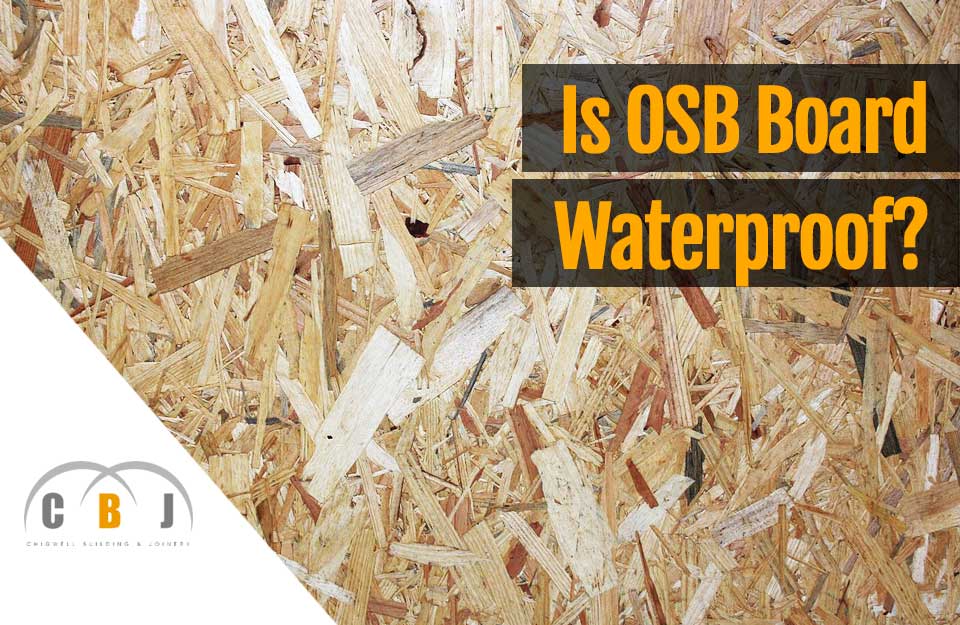News
Is OSB Board Waterproof?
Author Chigwell Building & Joinery
Date 01/07/2022
OSB or Oriented Strand Board, has become a popular alternative to traditional plywood.
While it offers a number of benefits, many are still concerned whether it’s robust enough if exposed to water or high levels of moisture.
Table of Contents
- What is OSB Board?
- Is OSB Board Waterproof?
- Should I Waterproof Seal OSB Board?
- Can OSB Board Get Wet?
- Can I Use OSB Board Outside?
- How to Protect OSB Board from Rain
- How to Make OSB Board Waterproof
- Conclusion
What is OSB Board?
Image credit: Wikipedia
OSB was invented back in 1963 by Armin Elmendorf.
This wood sheeting is made from 95% wood chips and 5% adhesive.
Indeed, OSB is made by mixing resin with strands of young wood to achieve a hard board.
This is then waterproofed to increase its durability.
This is very important especially if the OSB boards will be used in outdoor applications.
OSB boards are becoming quite popular as they are considerably thicker than plywood boards, and thus stronger than its counterpart as well.
OSB boards are used in various applications, including flooring, roof decks and even to make furniture.
Is OSB Board Waterproof?
OSB is made using waterproof resin adhesives.
The process that such boards undergo to be manufactured makes them highly water resistant.
This is due to the fact that the voids between the strands are very small.
Whatever gaps may be present, they will be filled with heat-cured waterproof resin adhesive and wax, in order to bond the wood chipping to each other.
As a result, all the wood strands in the board are coated, making the board water-resistant.
The edges are also treated with a sealer.
This gives the board additional moisture protection.
Even though OSB boards undergo such a process during manufacturing, it’s still best to fortify them with additional moisture protection before using them in an actual application.
This is because OSB boards are not exactly 100% waterproof, but are more accurately considered reasonably water-resistant.
It’s impossible to prevent water absorption completely as at the end of the day, this is a wood-based product.
However when compared with other types of materials, such as MDF boards for example, OSB is considerably better when it comes to moisture resistance.
Should I Waterproof Seal OSB Board?
Yes, it is a good idea to waterproof seal OSB boards.
When buying OSB boards, make sure that they have the ‘waterproof’ mark applied.
This is found on the back of the boards.
Despite this, it is still recommended to waterproof OSB boards, especially if they are going to be in an outdoor setting.
Can OSB Board Get Wet?
Image credit: Wikipedia
Generally speaking OSB boards are able to withstand 4 weeks of continuous moisture exposure.
There are even some which are rated to withstand up to 200 days of exposure without sustaining any damage.
However, if untreated cut boards are exposed to rain or standing water, the moisture absorption will be too excessive, so there’s a chance that swelling could occur.
If water exposure is prolonged, delamination is highly likely to result.
Therefore, OSB boards should not be left to get wet unnecessarily.
Painting or staining, and undergoing a waterproofing treatment is highly recommended, especially if the boards will be in an exterior setting.
Long term moisture exposure should be avoided, and if possible the boards should be covered or protected.
Can I Use OSB Board Outside?
OSB board can withstand exposure in an outdoor setting quite well.
It is important that if it’s going to be left outdoors, you choose OSB boards that are highly moisture resistant.
Hence, the boards should be packed with more strands, resin and wax to have superior moisture resistance level.
Such boards are classified as class 3 and they are the best type for humid conditions.
Such boards should also be given an additional layer of waterproofing as described above.
This offers them more resistance against moisture and water, which will inevitably be more present in an outdoor setting.
How to Protect OSB Board from Rain
If OSB boards are going to be left outdoors, ideally they should be covered to protect them from rain and moisture.
An odd rain shower should not cause much damage.
But if they’re exposed to several hours of rain, then they could end up swelling.
Covering with tarpaulin is also a good option to protect OSB boards from rain.
Another option is to spray them with exterior grade paint or a water sealer.
This is especially important for any cut edges on the boards.
If the boards have been used on roofs, they could be covered with roofing paper.
If they are used on walls they could be covered with a weather resistant barrier before siding.
Priming, painting or staining after construction has been completed is important.
How to Make OSB Board Waterproof
Image credit: Amazon
Make sure that you plan carefully before cutting the boards.
This is because whenever you cut, the sealer that was at the edges will be removed, and as a result moisture can be absorbed more easily into that area.
So waterproofing will need to be done after you’ve made the required cutting.
To make OSB boards more water resistant you can paint them.
If you are going to do this, it is best to paint them prior to carrying out the waterproofing process.
This will enable the paint layer to also be protected from water and moisture.
You may choose either latex-based or oil-based paint.
To waterproof OSB boards, choose a good quality waterproofing solution from any local hardware store.
Check that it can be applied to wood.
The solution can be applied by using a paintbrush, while making sure you coat all the board.
It is best to apply a second coating, and allow around 12 hours for the waterproofing to dry sufficiently.
Conclusion
OSB is a timber construction material that’s highly resistant to moisture.
When compared to other types of wood panels, it has a much slower moisture absorption rate.
Additionally, it can be water and weatherproofed for additional resistance, especially if it is going to be used outdoors.
This can be done very easily by using water repellent paints or stains.



